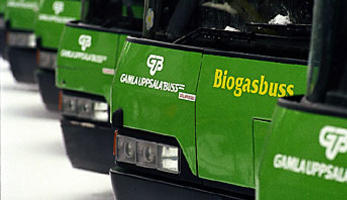Making clean vehicles less expensive
Thematic areas
Clean & energy-efficient vehicles
Summary
This two-part measure was aimed at reducing the purchase price of clean vehicles via a common nationwide procurement policy and the provision of subsidies.
Implementing sustainable mobility
Stockholm has political support for making its transport system even more environmentally friendly by substituting conventional vehicles with clean vehicles. One of the main objectives of this measure was to encourage vehicle manufacturers to produce clean vehicles and to make them available on the Swedish market. The common procurement of vehicles and the establishment of a network of companies using and promoting clean vehicles by means of a system of subsidies for part of the additional costs of a clean vehicle were two of the backbone tasks of this measure.
Progress
According to the original plan, two separate procurement procedures were to be carried out: one for biogas vehicles and one for electric hybrids. For practical reasons it was decided to coordinate the two procurement procedures. First, a market survey of approximately 10,000 enterprises and public institutions throughout Sweden was conducted in order to find out which vehicles could be provided by car dealers in Sweden.
The result was promising and a nationwide PR campaign was planned and carried out. The procurement team arranged meetings at 36 different locations throughout Sweden during the periods March to April and August to September 2002. Information materials on clean vehicles and fuels were produced and distributed at the meetings. The goal was to inform potential buyers about the market for clean vehicles and fuels and to assess their interest in taking part in a common procurement procedure. It became obvious that there was great interest in common procurement.
More than 50 municipalities and some 30 companies formed a buyer consortium. Kommentus, a procurement company owned by the municipalities in Sweden, undertook the procurement process. As a result, all the participating members of the consortium were offered better or much better prices.
The contract ran until the end of 2006. A study was also undertaken regarding the procurement of ethanol vehicles, including vehicle manufacturers and potential buyers. At the time of implementation, there was only one ethanol vehicle available on the Swedish market although the number of fuelling stations was relatively high (100 in Sweden, 15 of them in Stockholm). Since Swedish production of ethanol was increasing, it was essential to introduce a range of ethanol vehicles onto the market: without them, existing investments in fuelling stations and production plants would be wasted.
In a second step, a tool for disseminating information about clean vehicles was established in cooperation with the environmental manager at Swedish Television. Members of the so-called Network of Clean Drivers are companies in Stockholm that have at least one clean vehicle. They act as a strong body to increase the infrastructure for alternative fuels. A press conference was arranged at which the director of Swedish Television and four managers signed an agreement to join the Trendsetter project and the Clean Vehicle Network, committing them to purchase at least one clean vehicle. Members also undertook to spread knowledge about clean vehicles through clearly visible stickers and to collect and report data on maintenance costs and fuel consumption. Such data are essential for the further promotion of clean vehicles.
Through the Network of Clean Drivers, a total of 206 clean vehicles were introduced. The most popular models were the Toyota Prius (151 cars), Volvo Bi-Fuel (33 cars) and Mercedes Sprinter (five vans). The remaining 17 vehicles were various biogas cars and vans and one electric lorry.
Outcomes
The provision of subsidies to cover part of the additional cost of clean vehicles was an effective way of spreading the concept of clean vehicles. The press release on the Trendsetter subsidy available to companies in Stockholm created some 15 news articles during a period of six months, a very successful result according to PR experts. Hundreds of phone calls were also generated, giving the opportunity to provide tailor-made advice on clean vehicles to potential buyers.
Small companies were generally easier to reach than large fleet owners. This was due to the fact that the economic benefit of the subsidy was more important for small companies than for large fleet owners, such as taxi companies, that can normally obtain fairly low prices when buying large quantities. A subsidy is therefore an effective way to spread the use of clean vehicles to many different users, although large transport companies are difficult to reach via subsidies alone and other incentives, such as environmental requirements in public procurement, are necessary.
The technical evaluation of the vehicles operating within the framework of this measure shows that costs for maintenance and fuel are about the same for clean vehicles as for vehicles running on petrol or diesel.
The number of clean vehicles increased in private companies and among the general public due to a combination of lowered prices and subsidies. As a result of the measure, the share of energy from alternative fuels rose by 4,630 Tj per year and fossil-fuel carbon dioxide emissions fell by 430 tonnes per year and 100 g per vehicle kilometre per year.








